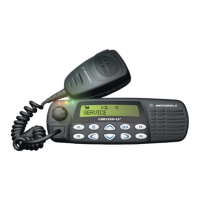_)
Theory of Operation
In the receive mode the
DC
voltage control line
is
at ground level which switches off the biasing
voltage
to
U3401 via U3503.
2.8.2 Driver Stage
2-27
The next stage
is
an
11
dB gain LDMOS device (Q3420) which requires a positive gate bias and a
quiescent current
flow for proper operation. The voltage
of
the line PCIC_MOSBIAS_1
is
set
in
transmit mode by PCIC pin 24 and fed to the gate of Q3420 via the resistive network R3525-6. The
bias
voltage
is
tuned in the factory.
2.8.3 Final Stage
The final stage is an enhancement-mode N-Channel LDMOS device (Q3440) providing a gain
of
17
dB. This device also requires a positive gate bias and a quiescent current flow for proper
operation. The
voltage
of
the line Bias_2_700_PA_1
is
set in transmit mode
by
the ASFIC and fed
to
the gate
of
Q3440 via the resistive network R3527 -8. This bias voltage is also tuned
in
the factory. If
the transistor
is
replaced, the bias voltage must be tuned using the Customer Programming
Software (CPS). Care must be taken not to damage the device by exceeding the maximum allowed
bias voltage. The device's drain current
is
drawn directly from the radio's de supply voltage input, A+,
via L3442. A matching network consisting
of
C3448-C3452 and L3442 transforms the impedance
to
50Q and feeds the antenna switch and harmonic filter.
2.8.4 Antenna Switch
The antenna switch utilizes the existing de feed (A+)
to
the last stage device (Q3440). Both PIN
diodes
03470
and 03471 are turned on during key-up
by
forward biasing them. Forward biasing
is
achieved pulling down the voltage at the cathode end
of
03471
to
around 11.8V (0.7V drop across
each diode). Q3471
is
configured as a current source that maintains the current through the
antenna switch diodes at
90 mA, as set by VR3470 and R3472. The current source
is
enabled only
during transmit by Q3470 and U3501 pin 32.
2.8.5 Harmonic Filter
Inductors L3474-6, capacitors C3481-2 and two microstrip stubs form a low-pass filter to attenuate
harmonic energy from the transmitter. R3475
is
used
to
drain any electrostatic charges that might
otherwise
build up on the antenna. The harmonic filter also prevents high level
RF
signals above the
receiver passband from reaching the receiver circuits, improving spurious response rejection. L3479
and C3492-3 form a trap that improves 2nd harmonic rejection.
2.8.6 Bi-Directional Coupler
The Bi-directional coupler
is
a microstrip printed circuit which couples a small amount
of
the forward
and reverse power
of
the
RF
power from Q3440. The coupled signal is rectified
to
an output power
proportional de voltage by the diodes
03472
and
03473
and sent to the RFIN
of
the PCIC. The
PCIC controls the gain
of
stage U3401 as necessary
to
hold this voltage constant. This ensures the
forward power out of the radio
is
held to a constant value.
2.8. 7 Power Control
The transmitter uses the Power
ControiiC
(PCIC, U3501)
to
control the power output
of
the radio. A
portion
of
the forward
RF
power from the transmitter is sampled by the bi-directional coupler and
rectified, to provide a
de
voltage to the RFIN port
of
the PCIC (pin
1)
which
is
proportional to the
sampled
RF
power.
The
PCIC has internal digital to analog converters (DACs) which provide the reference voltage
of
the control loop. The reference voltage level
is
programmable through the SPI line
of
the PC I
C.
This
reference
voltage is proportional to the desired power setting
of
the transmitter, and is factory

